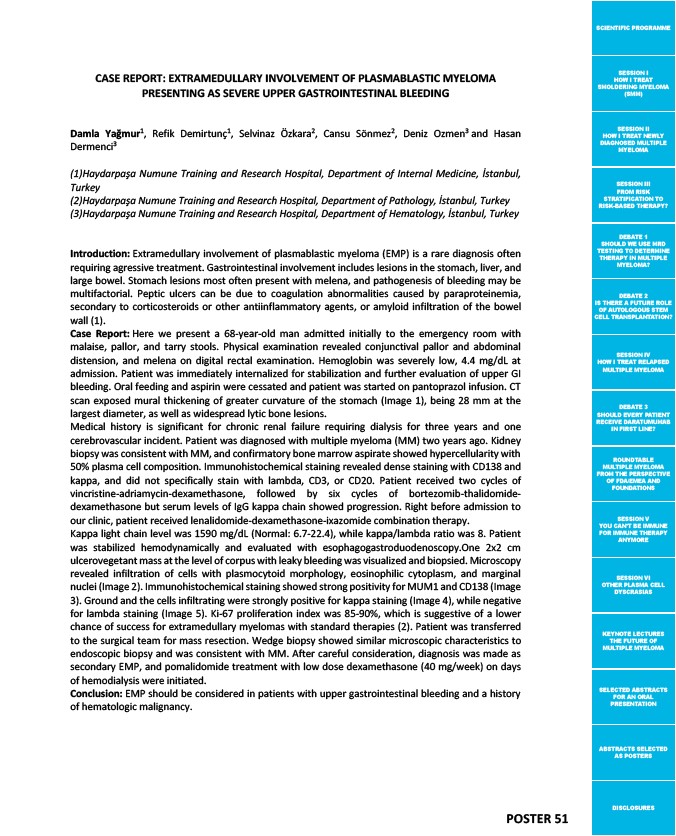
SCIENTIFIC PROGRAMME
SESSION I
HOW I TREAT
SMOLDERING MYELOMA
(SMM)
SESSION II
HOW I TREAT NEWLY
DIAGNOSED MULTIPLE
MYELOMA
SESSION III
FROM RISK
STRATIFICATION TO
RISK-BASED THERAPY?
DEBATE 1
SHOULD WE USE MRD
TESTING TO DETERMINE
THERAPY IN MULTIPLE
MYELOMA?
DEBATE 2
IS THERE A FUTURE ROLE
OF AUTOLOGOUS STEM
CELL TRANSPLANTATION?
SESSION IV
HOW I TREAT RELAPSED
MULTIPLE MYELOMA
DEBATE 3
SHOULD EVERY PATIENT
RECEIVE DARATUMUMAB
IN FIRST LINE?
ROUNDTABLE
MULTIPLE MYELOMA
FROM THE PERSPECTIVE
OF FDA/EMEA AND
FOUNDATIONS
SESSION V
YOU CAN’T BE IMMUNE
FOR IMMUNE THERAPY
ANYMORE
SESSION VI
OTHER PLASMA CELL
DYSCRASIAS
KEYNOTE LECTURES
THE FUTURE OF
MULTIPLE MYELOMA
SELECTED ABSTRACTS
FOR AN ORAL
PRESENTATION
ABSTRACTS SELECTED
AS POSTERS
DISCLOSURES
POSTER 51
CASE REPORT: EXTRAMEDULLARY INVOLVEMENT OF PLASMABLASTIC MYELOMA
PRESENTING AS SEVERE UPPER GASTROINTESTINAL BLEEDING
Damla Yağmur1, Refik Demirtunç1, Selvinaz Özkara2, Cansu Sönmez2, Deniz Ozmen3 and Hasan
Dermenci3
(1)Haydarpaşa Numune Training and Research Hospital, Department of Internal Medicine, İstanbul,
Turkey
(2)Haydarpaşa Numune Training and Research Hospital, Department of Pathology, İstanbul, Turkey
(3)Haydarpaşa Numune Training and Research Hospital, Department of Hematology, İstanbul, Turkey
Introduction: Extramedullary involvement of plasmablastic myeloma (EMP) is a rare diagnosis often
requiring agressive treatment. Gastrointestinal involvement includes lesions in the stomach, liver, and
large bowel. Stomach lesions most often present with melena, and pathogenesis of bleeding may be
multifactorial. Peptic ulcers can be due to coagulation abnormalities caused by paraproteinemia,
secondary to corticosteroids or other antiinflammatory agents, or amyloid infiltration of the bowel
wall (1).
Case Report: Here we present a 68-year-old man admitted initially to the emergency room with
malaise, pallor, and tarry stools. Physical examination revealed conjunctival pallor and abdominal
distension, and melena on digital rectal examination. Hemoglobin was severely low, 4.4 mg/dL at
admission. Patient was immediately internalized for stabilization and further evaluation of upper GI
bleeding. Oral feeding and aspirin were cessated and patient was started on pantoprazol infusion. CT
scan exposed mural thickening of greater curvature of the stomach (Image 1), being 28 mm at the
largest diameter, as well as widespread lytic bone lesions.
Medical history is significant for chronic renal failure requiring dialysis for three years and one
cerebrovascular incident. Patient was diagnosed with multiple myeloma (MM) two years ago. Kidney
biopsy was consistent with MM, and confirmatory bone marrow aspirate showed hypercellularity with
50% plasma cell composition. Immunohistochemical staining revealed dense staining with CD138 and
kappa, and did not specifically stain with lambda, CD3, or CD20. Patient received two cycles of
vincristine-adriamycin-dexamethasone, followed by six cycles of bortezomib-thalidomide-dexamethasone
but serum levels of IgG kappa chain showed progression. Right before admission to
our clinic, patient received lenalidomide-dexamethasone-ixazomide combination therapy.
Kappa light chain level was 1590 mg/dL (Normal: 6.7-22.4), while kappa/lambda ratio was 8. Patient
was stabilized hemodynamically and evaluated with esophagogastroduodenoscopy.One 2x2 cm
ulcerovegetant mass at the level of corpus with leaky bleeding was visualized and biopsied. Microscopy
revealed infiltration of cells with plasmocytoid morphology, eosinophilic cytoplasm, and marginal
nuclei (Image 2). Immunohistochemical staining showed strong positivity for MUM1 and CD138 (Image
3). Ground and the cells infiltrating were strongly positive for kappa staining (Image 4), while negative
for lambda staining (Image 5). Ki-67 proliferation index was 85-90%, which is suggestive of a lower
chance of success for extramedullary myelomas with standard therapies (2). Patient was transferred
to the surgical team for mass resection. Wedge biopsy showed similar microscopic characteristics to
endoscopic biopsy and was consistent with MM. After careful consideration, diagnosis was made as
secondary EMP, and pomalidomide treatment with low dose dexamethasone (40 mg/week) on days
of hemodialysis were initiated.
Conclusion: EMP should be considered in patients with upper gastrointestinal bleeding and a history
of hematologic malignancy.